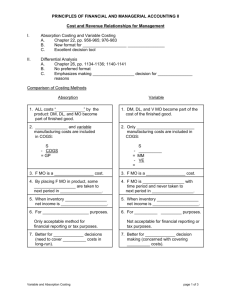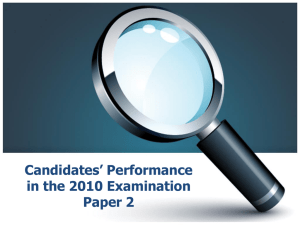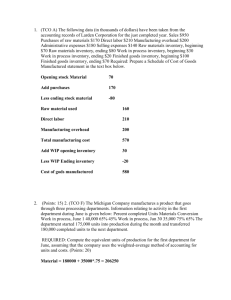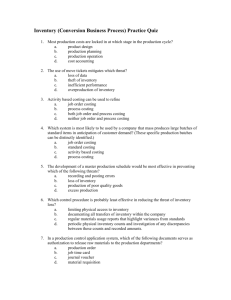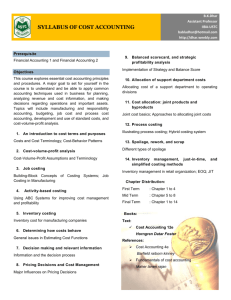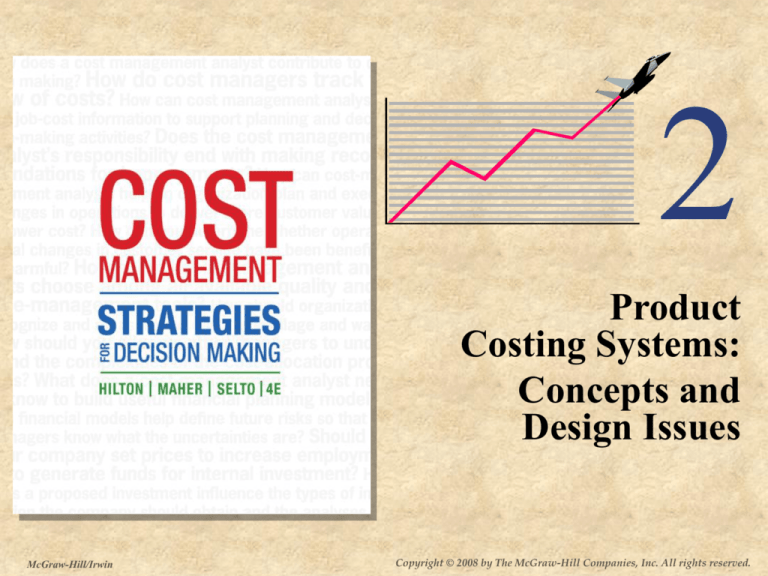
2
Product
Costing Systems:
Concepts and
Design Issues
McGraw-Hill/Irwin
Copyright © 2008 by The McGraw-Hill Companies, Inc. All rights reserved.
2-2
Learning Objective 1
2-3
The Meaning of Cost
Product Costs
• Related to the
purchase or
manufacture of
goods for resale.
• Assigned to
inventory and cost
of goods sold.
The use of
valuable
resources, in
order to achieve a
stated purpose. In
accounting, cost
is reported in
monetary terms.
Period Costs
• Related to selling
and administrative
operations.
• Recognized as
expenses in the
same time period.
2-4
Learning Objective 3
2-5
Comparing Service, Retail and
Manufacturing Companies
Service firms . . .
Provide a service that is
consumed when produced.
Have no inventories.
Retailers . . .
Buy finished goods.
Sell finished goods.
MegaLoMart
Manufacturers . . .
Buy raw materials.
Produce and sell finished goods.
2-6
Manufacturing Companies
The 3 major categories of
manufacturing costs:
Direct Materials
Raw materials,
components, and
other parts that
can be traced to a
specific product.
Direct Labor
Payments and
benefits for those
employees who
convert direct
materials into
finished product.
Manufacturing
Overhead
Indirect material
Indirect labor
Other overhead
2-7
Manufacturing Companies
Prime Costs include:
Direct Materials
Direct Labor
Manufacturing
Overhead
2-8
Manufacturing Companies
Conversion Costs include:
Direct Materials
Direct Labor
Manufacturing
Overhead
2-9
Stages of Production and the Flow
of Costs
Add:
=
Less:
=
Raw Materials
Beg. Inventory
Purchases
Raw Materials
Available for
Production
Raw Materials
Transferred to
Production
Ending Inventory
Add:
=
Less:
=
Work-In-Process
Beg. WIP Inventory
Raw Materials
Transferred In
Direct Labor
Manufacturing
Overhead
Total Manufacturing
Costs Incurred
Cost of Goods
Completed and
Transferred to
Finished Goods
Ending WIP
Inventory
Add:
=
Less:
=
Finished Goods
Beg. Inventory
Cost of Goods
Completed and
Transferred from
WIP
Goods Available for
Sale
Cost of Goods Sold
Ending Inventory
2-10
Stages of Production and the Flow
of Costs - Example
Add:
=
Less:
=
Raw Materials
Beg. Inventory
Purchases
Raw Materials
Available for
Production
Raw Materials
Transferred to
Production
Ending Inventory
What is Ending
Inventory in
February?
Axel Electronics makes toasters. On
February 1, Axel has $15,000 of raw
material on hand. Axel’s purchase
and transfers to the production floor
are indicated below.
Date
Feb 3
Feb 10
Feb 15
Feb 20
Feb 22
Feb 27
Cost of
Purchases
$
8,000
12,000
14,000
Cost of
Transfers
$
5,000
11,000
7,000
6,000
9,000
16,000
2-11
Stages of Production and the Flow
of Costs - Example
Add:
=
Less:
=
Raw Materials
$15,000
43,000
$58,000
45,000
$13,000
Now let’s look at
Work-in-Process.
Axel Electronics makes toasters. On
February 1, Axel has $15,000 of raw
material on hand. Axel’s purchase
and transfers to the production floor
are indicated below.
Date
Feb 3
Feb 10
Feb 15
Feb 20
Feb 22
Feb 27
Cost of
Purchases
$
8,000
12,000
14,000
Cost of
Transfers
$
5,000
11,000
7,000
6,000
9,000
16,000
2-12
Stages of Production and the Flow
of Costs - Example
Add:
=
Less:
=
Raw Materials
$15,000
43,000
$58,000
45,000
$13,000
Add:
=
What is the
amount of cost
transferred to
Finished Goods
in February?
Less:
=
Work-In-Process
Beg. WIP Inventory
Raw Materials
Transferred In
Direct Labor
Manufacturing
Overhead
Total Manufacturing
Costs Incurred
Cost of Goods
Completed and
Transferred to
Finished Goods
Ending WIP
Inventory
On February 1, Axel
had WIP of $30,000
on the factory floor.
During February,
Axel paid $92,000 in
direct labor wages.
Overhead is applied
at 150% of direct
labor. On 2/28,
$22,000 is still in
WIP.
2-13
Stages of Production and the Flow
of Costs - Example
150 % of $92,000
Add:
=
Less:
=
Raw Materials
$15,000
43,000
$58,000
45,000
$13,000
Now let’s
look at
Finished
Goods.
Add:
=
Less:
=
Work-In-Process
$30,000
45,000
92,000
138,000
$305,000
283,000
$22,000
Transferred
to Finished
Goods
On February 1, Axel
had WIP of $30,000
on the factory floor.
During February,
Axel paid $92,000 in
direct labor wages.
Overhead is applied
at 150% of direct
labor. On 2/28,
$22,000 is still in
WIP.
2-14
Stages of Production and the Flow
of Costs - Example
Add:
=
Less:
=
Raw Materials
$15,000
43,000
$58,000
45,000
$13,000
Add:
=
Less:
=
Work-In-Process
$30,000
45,000
92,000
138,000
$305,000
283,000
$22,000
Add:
=
Less:
=
Finished Goods
Beg. Inventory
Cost of Goods
Completed and
Transferred from
WIP
Goods Available for
Sale
Cost of Goods Sold
Ending Inventory
On February 1, Axel had Finished Goods of $125,000 on
hand. At the end of February, a physical inventory count
revealed $96,000 in Finished Goods still on hand.
What was Cost of Goods Sold for February?
2-15
Stages of Production and the Flow
of Costs - Example
Cost of goods sold
Add:
=
Less:
=
Raw Materials
$15,000
43,000
$58,000
45,000
$13,000
Add:
=
Less:
=
Work-In-Process
$30,000
45,000
92,000
138,000
$305,000
283,000
$22,000
Add:
=
Less:
=
Finished Goods
$125,000
283,000
$408,000
312,000
$96,000
On February 1, Axel had Finished Goods of $125,000 on
hand. At the end of February, a physical inventory count
revealed $96,000 in Finished Goods still on hand.
What was Cost of Goods Sold for February?
2-16
Learning Objective 2
2-17
Schedule of Cost of Goods
Manufactured
Let’s look at a
Schedule of Cost of
Goods Manufactured for
CollegePak Company.
2-18
Schedule of Cost of Goods
Manufactured
CollegePak Company
Schedule of Cost of Goods Manufactured
Raw material used
Direct labor
Total manufacturing overhead
$
850,000
700,000
1,850,000
Total manufacturing costs
Add: Work-in-process inventory, January 1
$ 3,400,000
350,000
Subtotal
Deduct: Work-in-process inventory, December 31
$ 3,750,000
400,000
Cost of goods manufactured
$ 3,350,000
2-19
Schedule
of Cost
Goods
Computation
of Costof
of Raw
Material Used
Raw-material inventory, January 1
$
Manufactured
Add: Purchases of raw materials
Raw material available for use
Deduct: Raw material inventory, December 31
Raw material used
CollegePak Company
200,000
800,000
1,000,000
150,000
$ 850,000
Schedule of Cost of Goods Manufactured
Raw material used
Direct labor
Total manufacturing overhead
$
850,000
700,000
1,850,000
Total manufacturing costs
Add: Work-in-process inventory, January 1
$ 3,400,000
350,000
Subtotal
Deduct: Work-in-process inventory, December 31
$ 3,750,000
400,000
Cost of goods manufactured
$ 3,350,000
2-20
Schedule of Cost of Goods
Manufactured
Include all direct labor
costs incurred during the
current period.
CollegePak
Company
Schedule of Cost of Goods Manufactured
Raw material used
Direct labor
Total manufacturing overhead
$
850,000
700,000
1,850,000
Total manufacturing costs
Add: Work-in-process inventory, January 1
$ 3,400,000
350,000
Subtotal
Deduct: Work-in-process inventory, December 31
$ 3,750,000
400,000
Cost of goods manufactured
$ 3,350,000
2-21
Schedule of Cost of Goods
Manufactured
Beginning work-inprocess inventory is
carried over from the
CollegePak Company
prior period.
Schedule of Cost of Goods Manufactured
Raw material used
Direct labor
Total manufacturing overhead
$
850,000
700,000
1,850,000
Total manufacturing costs
Add: Work-in-process inventory, January 1
$ 3,400,000
350,000
Subtotal
Deduct: Work-in-process inventory, December 31
$ 3,750,000
400,000
Cost of goods manufactured
$ 3,350,000
2-22
Schedule of Cost of Goods
Manufactured
Ending work-in-process inventory
contains the cost of unfinished goods,
and is reported
in the current assets
CollegePak
Company
section
of the
balance sheet.
Schedule of Cost
of Goods
Manufactured
Raw material used
Direct labor
Total manufacturing overhead
$
850,000
700,000
1,850,000
Total manufacturing costs
Add: Work-in-process inventory, January 1
$ 3,400,000
350,000
Subtotal
Deduct: Work-in-process inventory, December 31
$ 3,750,000
400,000
Cost of goods manufactured
$ 3,350,000
2-23
Income Statement for a
Manufacturer
Now let’s look at an income
statement for CollegePak.
2-24
Income Statement for a
Manufacturer
CollegePak Company
Income Statement
For the Year Ended December 31, 20X2
Sales revenue
Less: Cost of goods sold
$ 4,500,000
2,810,000
Gross margin
Selling and administrative expenses
$ 1,690,000
1,440,000
Operating profit before taxes
$
250,000
2-25
Income Statement for a
Manufacturer
CollegePak Company
Schedule of Cost of Goods Sold
For the Year Ended December 31, 20X2
Finished-goods inventory, Jan. 1
Add: Cost of goods manufactured
Cost of goods availableCollegePak
for sale
Company
Deduct Finished-goods inventory, Dec. 31
$
920,000
3,350,000
4,270,000
1,460,000
Income Statement
$ 2,810,000
For the Year Ended December 31, 20X2
Cost of goods sold
Sales revenue
Less: Cost of goods sold
$ 4,500,000
2,810,000
Gross margin
Selling and administrative expenses
$ 1,690,000
1,440,000
Operating profit before taxes
$
250,000
2-26
Production Costs in the Service
Sector
A service provider cannot
“inventory” its services.
The costs of providing the
service can be identified and
measured, just as occurs in
manufacturing industries.
Managing and tracking the
costs associated with valuechain activities can point to
opportunities for improvement.
2-27
Cost Drivers
An “activity” is any
discrete task that an
organization
undertakes to make
or deliver a good or
service.
A “cost driver” is
some characteristic
of the activity that
causes costs to be
incurred.
Number of
computers made by
Dell in a day
Number of
flights by Southwest
Airlines in a given market
2-28
Learning Objective 4
2-29
Cost Behavior
Cost behavior means how
a cost will react to
changes in the level of
business activity.
Total variable costs
change when activity
level changes.
Total fixed costs remain
unchanged when activity
level changes.
2-30
Total Variable Cost Example
Total Long Distance
Telephone Bill
Your total long distance telephone bill
is based on how many minutes you talk.
Minutes Talked
2-31
Variable Cost Per Unit Example
Per Minute
Telephone Charge
The cost per long distance minute talked is
constant. For example, 5 cents per minute.
Minutes Talked
2-32
Total Fixed Cost Example
Monthly Basic
Telephone Bill
Your monthly basic telephone bill
probably does not change when you
make more local calls.
Number of Local Calls
2-33
Fixed Cost Per Unit Example
Monthly Basic Telephone
Bill per Local Call
The average cost per local call
decreases as more local calls are made.
Number of Local Calls
2-34
Cost Behavior Summary
Summary of Variable and Fixed Cost Behavior
Cost
In Total
Per Unit
Variable
Changes proportionately with
changes in activity within the
relevant range.
Remains constant for each
additional unit as long as activity
is in the relevant range.
Fixed
Remains the same even when
activity changes within the
relevant range.
The per unit amount changes
each time the level of activity
changes due to the fixed nature
of the related costs.
2-35
Cost Hierarchy
Unit-level
Costs
Directly traceable
to the decision to
produce the level
of output
Costs that are incurred for every unit of product
manufactured or service produced.
Includes direct material, direct labor, utilities to
run equipment, other overhead directly related to
the production process.
All unit level costs are variable, but not
all variable costs are unit level costs.
2-36
Cost Hierarchy
Batch-level
Costs
Costs that are incurred for batch of product
manufactured or service produced.
Includes setup costs, material-handling costs
related to delivering raw material to the
production line, etc.
2-37
Cost Hierarchy
Product-level
Costs
Costs that are incurred for each line of product
or service.
Includes design costs for product lines and
marketing costs for each product line.
2-38
Cost Hierarchy
Facility-level
Costs
Costs that are incurred to maintain the
organization’s overall facility and infrastructure.
Includes production manager’s salary, plant
depreciation, and insurance on the facility and
equipment.
2-39
Learning Objective 5
2-40
Committed and Discretionary Costs
Committed
Discretionary
Long-term obligations,
difficult to change in
the short term.
Easier to alter in the
short term by current
managerial decisions.
Rental and/or
Lease Financing
of Buildings and
equipment
Advertising and
Research and
Development
2-41
Opportunity Costs
The potential benefit that is given up when
one alternative is selected over another.
If you were not attending
college, you could be
earning $20,000 per year.
Your opportunity cost of
attending college for
one year is $20,000.
2-42
Sunk Costs
Past payments for resources that cannot be changed
by any current or future decision.
Sunk costs should not be considered in decisions.
Example: You bought an automobile for $12,000 two
years ago. Whatever you do with the automobile in
the future, you cannot nullify the original transaction. If
it has a trade-in value, that value would become an
opportunity cost in your future decisions.
2-43
Traceability of Resources
Direct Costs
Indirect Costs
Costs that can be
traced easily and
conveniently to a
product or department.
Costs that need to be
allocated, before they
can be assigned to a
product or department.
Example: Cost of paint in
the paint department of
an automobile assembly
plant.
Example: Cost of
national advertising for
an airline is indirect to a
given flight or route.
2-44
Learning Objective 6
2-45
Absorption (Full) Costing
A system of accounting for costs in which
both fixed and variable production costs
are included in product costs.
Fixed
Costs
Product
Variable
Costs
2-46
Variable Costing
A system of cost accounting that assigns only the
variable cost of production to products.
Fixed
Costs
Product
Variable
Costs
2-47
Learning Objective 7
2-48
Absorption Costing vs. Variable
Costing
Absorption
Costing
Product costs
Variable
Costing
Direct materials
Direct labor
Variable mfg. overhead
Product costs
Fixed mfg. overhead
Period costs
Period costs
Selling & admin. exp.
2-49
Absorption and Variable Costing
Let’s see what we can learn about the
differences between absorption and variable
costing by looking at a numerical example.
2-50
Absorption Costing vs. Variable
Costing - Example
Howell, Inc. produces a single product with a sales price
of $40 and the following cost information:
2-51
Absorption Costing vs. Variable
Costing - Example
Unit product cost is determined as follows:
Selling and administrative expenses are
always treated as period expenses and deducted from
revenue as they are incurred.
2-52
Absorption Costing vs. Variable
Costing - Example
Howell, Inc. had no beginning inventory, produced
30,000 units and sold 28,000 units this year.
Absorption Costing
Sales (28,000 × $40)
Less cost of goods sold:
Beginning inventory
$
Add COGM (30,000 × $19)
570,000
Goods available for sale
570,000
Ending inventory (2,000 × $19)
38,000
Gross margin
Less selling & admin. exp.
Variable (28,000 x $4)
$ 112,000
Fixed
250,000
Net income
$ 1,120,000
532,000
588,000
$
362,000
226,000
2-53
Absorption Costing vs. Variable
Costing - Example
Variable
costs
only.
Variable Costing
Sales (28,000 × $40)
Less variable expenses:
Beginning inventory
$
Add COGM (30,000 × $12)
360,000
Goods available for sale
360,000
Ending inventory (2,000 × $12)
24,000
Variable cost of goods sold
336,000
Variable selling & administrative
expenses (28,000 × $4)
112,000
Contribution margin
Less fixed expenses:
Manufacturing overhead
$ 210,000
Selling & administrative expenses
250,000
Net income
$ 1,120,000
All fixed
manufacturing
overhead is
expensed.
448,000
672,000
$
460,000
212,000
2-54
Comparing Absorption and
Variable Costing
Let’s compare the methods.
Cost of
Goods
Sold
Ending
Inventory
Period
Expense
Absorption costing
Variable mfg. costs $ 336,000
Fixed mfg. costs
196,000
$ 532,000
$ 24,000
14,000
$ 38,000
$
Variable costing
Variable mfg. costs $ 336,000
Fixed mfg. costs
$ 336,000
$ 24,000
$ 24,000
$
$
-
210,000
$ 210,000
Total
$ 360,000
210,000
$ 570,000
$ 360,000
210,000
$ 570,000
2-55
Reconciling Income
We can reconcile the difference between
absorption and variable net income as follows:
Variable costing net income
Add: Fixed mfg. overhead costs
deferred in inventory
(2,000 units × $7 per unit)
Absorption costing net income
Fixed mfg. overhead
$210,000
=
Units produced
30,000
$ 212,000
14,000
$ 226,000
= $7.00 per unit
2-56
Extending the Example
Let’s look at
the second
year of
operations
for Howell, Inc.
2-57
Howell Inc., Year 2
In its second year of operations, Howell started with an
inventory of 2,000 units, produced 30,000 units and sold
32,000 units at $40 each.
2-58
Howell Inc., Year 2
Unit product cost is determined as follows:
There has been no
change in Howell’s
cost structure.
2-59
Howell Inc., Year 2
Units in ending inventory from the previous period.
Absorption Costing
Sales (32,000 × $40)
Less cost of goods sold:
Beg. inventory (2,000 x $19)
Add COGM (30,000 × $19)
Goods available for sale
Ending inventory
Gross margin
Less selling & admin. exp.
Variable (32,000 × $4)
Fixed
Net income
$ 1,280,000
$ 38,000
570,000
$ 608,000
$
608,000
672,000
$
378,000
294,000
$ 128,000
250,000
30,000 units produced in the current period.
2-60
Howell Inc., Year 2
Variable Costing
Sales (32,000 × $40)
Less variable expenses:
Beg. inventory (2,000 × $12)
Add COGM (30,000 × $12)
Goods available for sale
Ending inventory
Variable cost of goods sold
Variable selling & administrative
expenses (32,000 × $4)
Contribution margin
Less fixed expenses:
Manufacturing overhead
Selling & administrative expenses
Net income
$ 1,280,000
$
24,000
360,000
$ 384,000
$ 384,000
128,000
$
512,000
768,000
$
460,000
308,000
$ 210,000
250,000
2-61
Summary
Income Comparison
Costing Method
Absorption
Variable
1st Period
$ 226,000
212,000
2nd Period
$ 294,000
308,000
Total
$ 520,000
520,000
In the first period, production (30,000 units)
was greater than sales (28,000).
In the second period, production (30,000 units)
was less than sales (32,000).
For the two-year period, total absorption
income and total variable income are the same.
2-62
Summary
2-63
Learning Objective 8
2-64
Variable versus Absorption Costing
All manufacturing
costs must be assigned
to products to properly
match revenues and
costs.
Absorption
Costing
Fixed costs are
not really the costs
of any particular
product.
Variable
Costing
2-65
Variable versus Absorption Costing
Depreciation,
taxes, insurance and
salaries are just as
essential to products
as variable costs.
Absorption
Costing
These are capacity
costs and will be
incurred even if nothing
is produced.
Variable
Costing
2-66
Variable versus Absorption Costing
Absorption
costing product costs
are misleading for
decision making.
Variable
Costing
They are the
numbers that
appear on our
external
reports.
Absorption
Costing
2-67
Variable versus Absorption
Costing
Absorption Costing
Cost of goods sold decreases because production
exceeds sales, leaving a portion of fixed
manufacturing costs in inventory.
Variable cost
Fixed manufacturing overhead
Units sold
Units Total Variable
Produced
Cost
10,000
$100,000
12,000
$120,000
14,000
$140,000
16,000
$160,000
18,000
$180,000
20,000
$200,000
$10
$100,000
10,000
Fixed
Total
Average
Manufacturing Manufacturing Manufacturing
Overhead
Cost
Cost
$100,000
$200,000 $
20.00
$100,000
$220,000 $
18.33
$100,000
$240,000 $
17.14
$100,000
$260,000 $
16.25
$100,000
$280,000 $
15.56
$100,000
$300,000 $
15.00
Cost of
Goods Sold
$ 200,000
$ 183,333
$ 171,429
$ 162,500
$ 155,556
$ 150,000
Absorption Costing
Cost of goods sold decreases because production
exceeds sales, leaving a portion of fixed
manufacturing costs in inventory.
2-68
Variable versus Absorption Costing
COGS for 10,000 units
$150,000
0
00
34
,
0
00
30
,
0
00
26
,
0
00
22
,
0
00
18
,
0
00
14
,
00
0
$100,000
10
,
COGS
$200,000
Number of units produced
2-69
Throughput Costing
Unit-level
spending for
direct costs
Product
cost
Indirect, past
or committed
costs
Unit-level costs are incurred every time a unit of
product is manufactured and will not be incurred
again until the next unit is manufactured.
2-70
Throughput Costing
Example
In an automated process direct material may be
the only unit-level cost and so is the only product cost.
All other manufacturing costs are expensed as period costs.
Incentive to
overproduce
is reduced
Average unit cost does
not vary with changes
in production levels.
Advantages
2-71
Learning Objective 9
2-72
Intentional Overproduction of Inventory
Absorption costing: Excess inventory would
include more fixed production costs, so that gross
income for the period would be artificially higher.
An unethical manager would have an incentive to
“produce for inventory” at the end of a period, in
order to obtain a better looking bottom line.
Throughput costing: No such incentive would
exist, since fixed production costs would be
charged against operating income for the period.
2-73
End of Chapter 2

